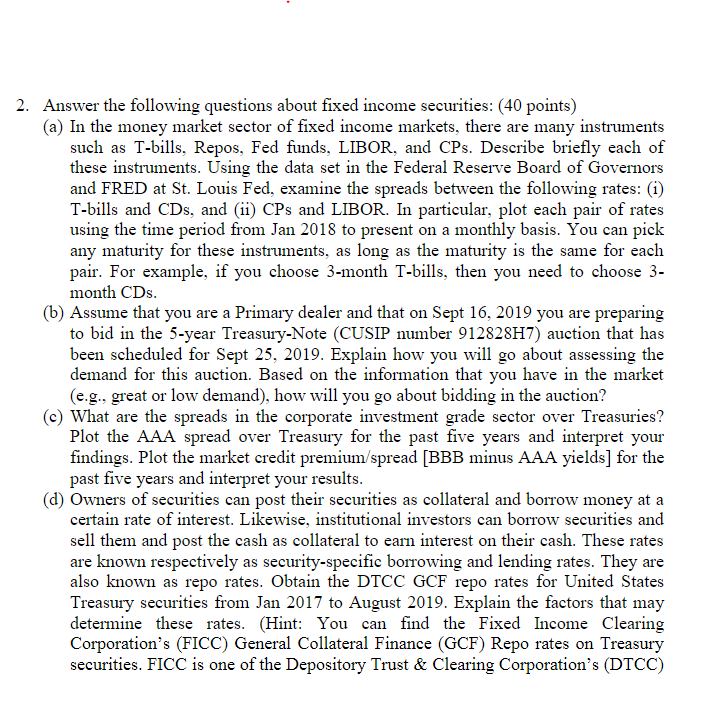
2. Answer the following questions about fixed income securities: (40 points) (a) In the money market sector of fixed income markets, there are many instruments such as T-bills, Repos, Fed funds, LIBOR, and CPs. Describe briefly each of these instruments. Using the data set in the Federal Reserve Board of Governors and FRED at St. Louis Fed, examine the spreads between the following rates: (i) T-bills and CDs, and (ii) CPs and LIBOR. In particular, plot each pair of rates using the time period from Jan 2018 to present on a monthly basis. You can pick any maturity for these instruments, as long as the maturity is the same for each pair. For example, if you choose 3-month T-bills, then you need to choose 3- month CDs. (b) Assume that you are a Primary dealer and that on Sept 16, 2019 you are preparing to bid in the 5-year Treasury-Note (CUSIP number 912828H7) auction that has been scheduled for Sept 25, 2019. Explain how you will go about assessing the demand for this auction. Based on the information that you have in the market (e.g., great or low demand), how will you go about bidding in the auction? (c) What are the spreads in the corporate investment grade sector over Treasuries? Plot the AAA spread over Treasury for the past five years and interpret your findings. Plot the market credit premium/spread [BBB minus AAA yields] for the past five years and interpret your results. (d) Owners of securities can post their securities as collateral and borrow money at a certain rate of interest. Likewise, institutional investors can borrow securities and sell them and post the cash as collateral to earn interest on their cash. These rates are known respectively as security-specific borrowing and lending rates. They are also known as repo rates. Obtain the DTCC GCF repo rates for United States Treasury securities from Jan 2017 to August 2019. Explain the factors that may determine these rates. (Hint: You can find the Fixed Income Clearing Corporation's (FICC) General Collateral Finance (GCF) Repo rates on Treasury securities. FICC is one of the Depository Trust & Clearing Corporation's (DTCC) 2. Answer the following questions about fixed income securities: (40 points) (a) In the money market sector of fixed income markets, there are many instruments such as T-bills, Repos, Fed funds, LIBOR, and CPs. Describe briefly each of these instruments. Using the data set in the Federal Reserve Board of Governors and FRED at St. Louis Fed, examine the spreads between the following rates: (i) T-bills and CDs, and (ii) CPs and LIBOR. In particular, plot each pair of rates using the time period from Jan 2018 to present on a monthly basis. You can pick any maturity for these instruments, as long as the maturity is the same for each pair. For example, if you choose 3-month T-bills, then you need to choose 3- month CDs. (b) Assume that you are a Primary dealer and that on Sept 16, 2019 you are preparing to bid in the 5-year Treasury-Note (CUSIP number 912828H7) auction that has been scheduled for Sept 25, 2019. Explain how you will go about assessing the demand for this auction. Based on the information that you have in the market (e.g., great or low demand), how will you go about bidding in the auction? (c) What are the spreads in the corporate investment grade sector over Treasuries? Plot the AAA spread over Treasury for the past five years and interpret your findings. Plot the market credit premium/spread [BBB minus AAA yields] for the past five years and interpret your results. (d) Owners of securities can post their securities as collateral and borrow money at a certain rate of interest. Likewise, institutional investors can borrow securities and sell them and post the cash as collateral to earn interest on their cash. These rates are known respectively as security-specific borrowing and lending rates. They are also known as repo rates. Obtain the DTCC GCF repo rates for United States Treasury securities from Jan 2017 to August 2019. Explain the factors that may determine these rates. (Hint: You can find the Fixed Income Clearing Corporation's (FICC) General Collateral Finance (GCF) Repo rates on Treasury securities. FICC is one of the Depository Trust & Clearing Corporation's (DTCC)







